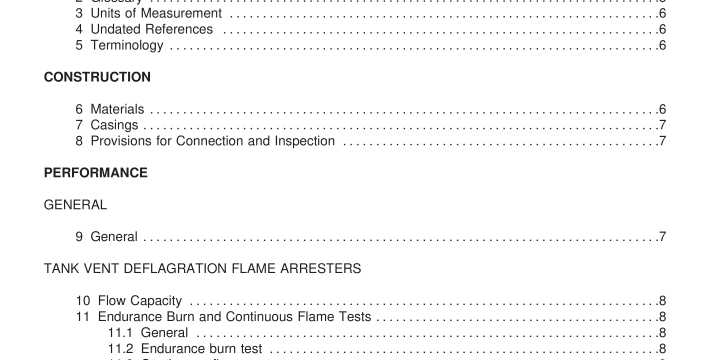UL 525-2008 pdf download.Flame Arresters.
10 Flow Capacity 1 0.1 The flow capacity of a flame arrester shall be determined at the operating pressures (both positive and negative) specified for the arrester by the manufacturer. 1 0.2 When a flame arrester is intended for use as an emergency vent, the flow capacity shall be determined at the pressure at which the valve reaches the full open position. If the pressure at full open position is greater than 2.5 psi, and the start to open pressure is less than 2.5 psi, the flow capacity shall also be determined at 2.5 psi. 11 Endurance Burn and Continuous Flame Tests 11.1 General 1 1 .1 .1 A Type I flame arrester shall be subjected to the Endurance Burn Test described in 1 1 .2.1 – 1 1 .2.9 and there shall be no passage of flame, both during the test and when the gas valve is closed at the conclusion of the test. 1 1 .1 .2 A Type II flame arrester shall be subjected to the Continuous Flame Test specified in 1 1 .3.1 – 1 1 .3.5 and marked in accordance with 24.1 (e). 1 1 .1 .3 When a flame arrester is to be provided with cowls, weatherhoods, deflectors, and similar components, it is to be tested in each configuration in which it is to be provided. 11.2 Endurance burn test 1 1 .2.1 The flammable mixture for the test is to be a 2.5 percent mixture by volume of n-hexane in air or a 1 .9 percent mixture by volume of gasoline vapor in air.
1 1 .2.2 The flame arrester is to be mounted on a tank so that the mixture emission is vertically upwards, or mounted in the position for which it is designed and which will result in the most severe heating of the arrester. When the arrester is provided with a vent valve, the valve is to be open for the test. 1 1 .2.3 The tank mentioned in 1 1 .2.2 is to be provided with a burst diaphragm at one end and an inlet for the mixture at the other end. 1 1 .2.4 The burst diaphragm is to be made of 0.001 5- to 0.01 0-inch (0.038- to 0.2540-mm) thick cellulose acetate film, polyester film, polyethylene terephthalate film, or the equivalent. 1 1 .2.5 The mixture is to be introduced into the tank and is to be ignited by a pilot flame or spark plug at the outlet of the flame arrester. The mixture may be reignited as necessary during the test. 1 1 .2.6 Temperatures are to be measured on the surface of the protected side of the arrester element at its center, at its edge, and halfway between the center and the edge.
1 1 .2.7 The concentration and the flow rate of the mixture are to be varied while maintaining a flame on the surface of the arrester for at least 2 hours or until the temperature on the protected side has a temperature rise of at least 1 00°C (1 80°F). After 2 hours or a 1 00°C rise, the procedure is to be continued until the highest obtainable temperature is reached on the protected side of the arrester. 1 1 .2.8 The highest obtainable temperature is identified as being reached when the temperature rise does not exceed 0.5°C (0.9°F) per minute over a 1 0-minute period, regardless of the concentration and flow rate. 1 1 .2.9 The highest obtainable temperature is to be maintained for 1 0 additional minutes without additional temperature rise after which the flow is to be stopped. Observation is to be made to determine if flashback occurs. 11.3 Continuous flame test 1 1 .3.1 The flame arrester is to be subjected for 1 hour (or longer at the manufacturer’s request) to the flame of a continuously burning mixture of gasoline vapor and air at a concentration of 1 .9 ±0.05 percent by volume. The total burning time in this test until flashback occurs or the test is discontinued shall be used for the marking in 24.1 (e). 1 1 .3.2 The flame arrester is to be connected as intended for installation: a) Using the maximum length of pipe intended, if marked on the arrester in accordance with 24.1 (a) and not less than 5 feet (1 .5 m); b) Discharging directly to the atmosphere when intended for such use; or c) Connected to the specific vent-valve intended, with the valve open for the test. 1 1 .3.3 The mixture is to be introduced into the inlet (tank) end of the test installation at the rate specified in Table 1 1 .1 and is to be burned at the outlet face of the arrester.UL 525-2008 pdf download.
UL 525-2008 pdf download
